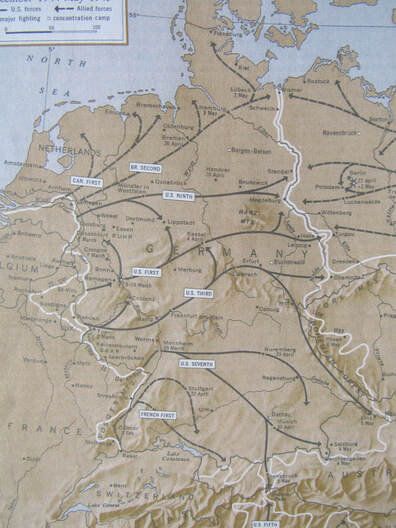 The story begins in 1837 when forty-one-year-old Maria Anna Schickelgruber finds herself pregnant and unmarried. Shunned by the locals in her village of Strones, Austria, she gives birth to a boy, who she names Alois. Since Strones is too small to be a parish, the child is baptized in nearby Dollersheim as Alois Schickelgruber. The entry for “father” is left blank and Alois is listed as “illegitimate”. An investigation in 1930 identifies three strong candidates for the father of Alois: a nineteen-year-old Jewish teenager whose last name is Frankenberger; a man named Johann Georg Hiedler; and the brother of Georg, Johann Nepomuk Hiedler. The teenaged Frankenberger was a strong candidate because Maria Anna Schickelgruber had been employed as a maid and cook in the Frankenberger household, and from the day of Alois’ birth and continuing until his fourteenth year, Frankenberger’s wealthy father paid Maria Anna “maintenance” for Alois on behalf of his son. There is no explicit declaration of fatherhood, but the Frankenbergers’ correspondence with Maria reflected a tacit understanding that the circumstances made it a duty of the Frankenbergers to pay for the boy’s maintenance. Johann Georg Heidler is a strong candidate because he marries Maria Anna Schickelgruber five years after Alois’ birth. Georg seems to have been a journeyman-miller who never had a full-time job. According to one source, Georg and Maria were so impoverished that they did not even possess a bed and had to sleep in a feeding trough for cattle. Because of this desperate poverty, Maria asked Georg’s brother to take Alois and raise him as his son. Johann Nepomuk Hiedler accepts Alois and raises him on a farm in Spital, Austria. Maria dies in 1847, when Alois is ten, and he never sees his stepfather again; Georg dies in 1857. A case is made that Nepomuk did this willingly because he was actually Alois’ father to begin with, so he becomes the third strong candidate for the missing father. In spite of all the research done over the years, none of the three men were proven to be Alois’ real father and the situation was never resolved. The truth will probably never be known. Several years after living with Nepomuk, Alois is first apprenticed to a shoemaker in Vienna, and then takes a position with the Imperial Board of Revenue. By hard work and dedication, he rises to the highest position available to him according to his background and education. Nepomuk is proud of his foster son and urges Alois to change his name to Hiedler. Alois thinks this is a good idea, since it would help erase his illegitimacy. In 1877, with a few family members, they journey to the town of Wietra and swear before a local notary that Johann Georg Heidler is Alois’s true father. The paperwork is completed and the new name becomes official. No one notices that the name on the paperwork has been misspelled or had been misheard by the notary. It states that Johann Georg’s last name is “Hitler” instead of “Heidler.” The next day the same group travels to Dollersheim and persuades the elderly parish priest to alter Alois’ birth certificate. He fills in the father’s name, changes “illegitimate” to “legitimate”, crosses out Alois’ name as “Schickelgruder” and writes in “Hitler” as the official paperwork states. The priest then adds this note in the margin: “The undersigned confirm that Georg Hitler, registered as the father, who is well-known to the undersigned witnesses, admits to being the father of the child Alois as stated by the child’s mother Maria Anna Schickelgruber, and has requested the entry of his name in the present baptismal register.” It should be noted that both Georg and Maria were long dead by then. The new Alois Hitler will marry at least three women and produce several children. The most significant will be a son born to his third wife, a domestic servant from Spital, whose maiden name is Klara Polzl. Klara has three children die in infancy, and then gives birth to a fourth, a son, on April 20, 1889, in the Austro-German border town of Braunau on the River Inn. He is named Adolf. Alois dies in 1903, at the age of sixty-five, when Adolf is fourteen. Klara dies in 1907 from the use of iodoform to treat breast cancer. Adolf is eighteen and is reportedly devastated by her death. To sum up the situation, Adolf Hitler is the son of Alois and Klara Hitler, while Alois is the son of Maria Anna Schickelgruber and an unknown father. In Mein Kampf, Adolf merely states that his father was an imperial customs official, the grandfather “a poor cottager,” while idealizing his mother as a loving and devoted housewife. This all makes possible some severe complications. Klara Polzl was also the granddaughter of Johann Nepomuk Hiedler, Alois’ foster father. If Nepomuk was Alois’ real father, as was suggested, that makes Adolf Hitler’s paternal grandfather and his maternal great-grandfather one and the same. It would also mean, as one historian points out, that Klara is the niece of Alois Hitler and the daughter of his half-sister. The marriage of the two becomes a case of family inbreeding (which was not uncommon at the time) and furnishes ample reason why Adolf Hitler, eager to portray himself as a pure German, did not want too much certainty about his ancestors. Worse, yet, if the nineteen-year-old Frankenberger, the son of a wealthy Jew, was the real father of Alois, Adolf has a career-ending problem. A basic premise in Nazi philosophy, for which Hitler was majorly responsible, is that Jews are the enemies of the Aryan race, and any hint of Jewish blood in a German is indicative of a degraded heritage. That is, they not a true Aryan. Adolf certainly would never have qualified to be the German Chancellor or even the leader of the Nazi Party. It was Adolf Hitler himself who had privately ordered his ancestry investigation in 1930. The findings about the Frankenbergers were probably uncorroborated and based on hearsay, but Hitler rejected the whole investigation as blatant lies, making sure that his ancestry remained obscure while he continued to see himself as the full and true embodiment of the German Nation. It is interesting that his later rule of Germany would sometimes include requiring citizens to prove their Aryan decent or disprove Jewish descent, something he could not even do himself. The private 1930 investigation, by the way, did not come to light until the period of the Nuremberg Trials, after the war. It was reported by the investigator in his autobiography. In July of 1938, two months after Hitler annexes Austria, the Austrian Land Registries received an order to conduct a land survey of Dollersheim and surrounding areas. The enquiry is to determine whether the terrain was suitable for army maneuvers. Apparently, it was, so in 1939 the citizens of Dollersheim were forcibly evacuated and the village, along with its heavily wooded countryside, was blasted beyond recognition by mortar shells and thoroughly plowed over by army tanks. The birthplace of Hitler’s father, Alois, the site of his grandmother’s grave, and the official center of the parish were rendered unrecognizable. I wouldn’t be surprised if any hints of the Frankenbergers were also erased, but I’m just guessing. I found this to be an interesting sidelight to German history, although even the summary above leaves several questions hanging. My information comes from Nazi Germany, A New History, by Klaus P. Fischer, published by The Continuum Publishing Company, 1995. Reading the footnotes to the text, almost every step of the history cited above has differing opinions. Researching Hitler’s childhood is a fascinating topic to a number of historians and subsequent theories are wide-ranging and sometimes too remarkable to believe.
1 Comment
Donna Bogan
1/3/2022 04:56:31 am
Wow! I have never read any speculation or seen any research stating that Hitler’s family tree didn’t fork!Thanks for bringing this to the light.
Reply
Leave a Reply. |
AuthorDon Willerton has been a reader all his life and yearns to write words like the authors he has read. He's working hard at it and invites others to share their experiences. |

 RSS Feed
RSS Feed